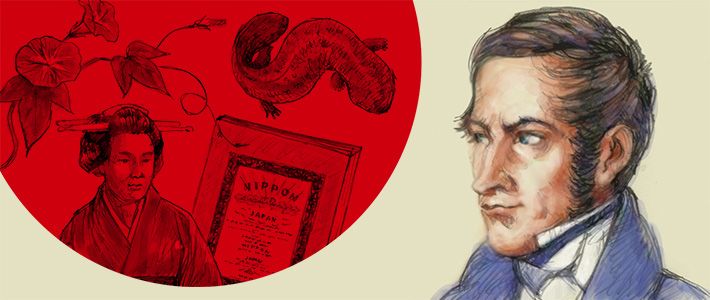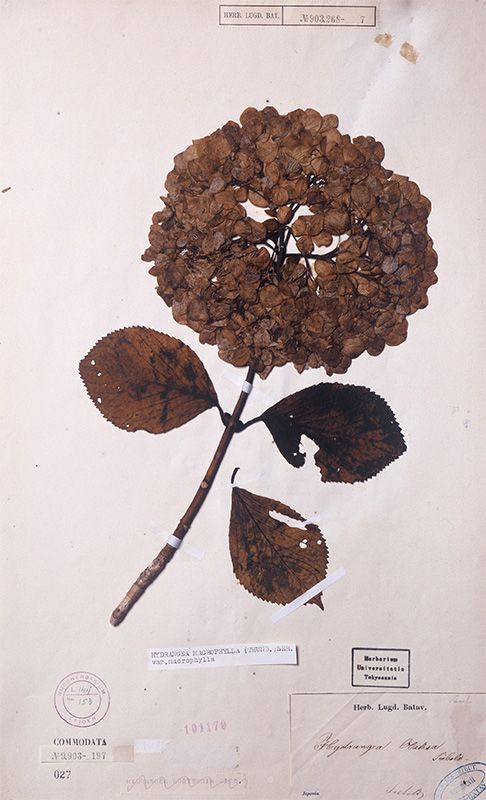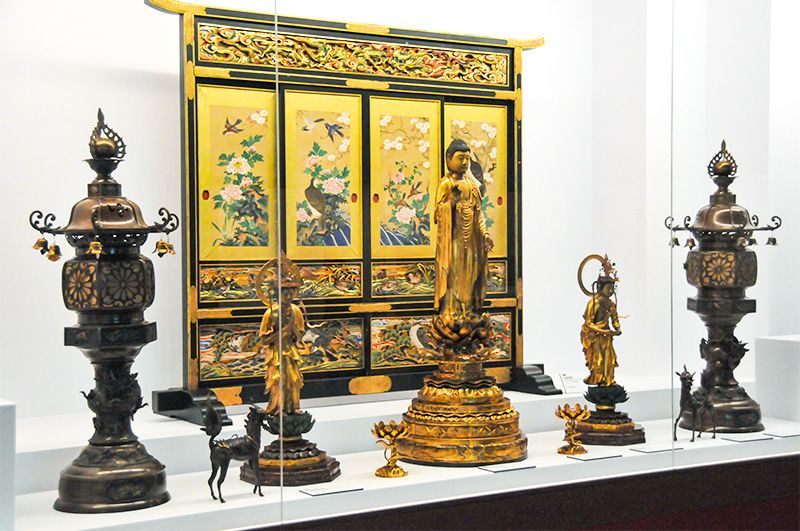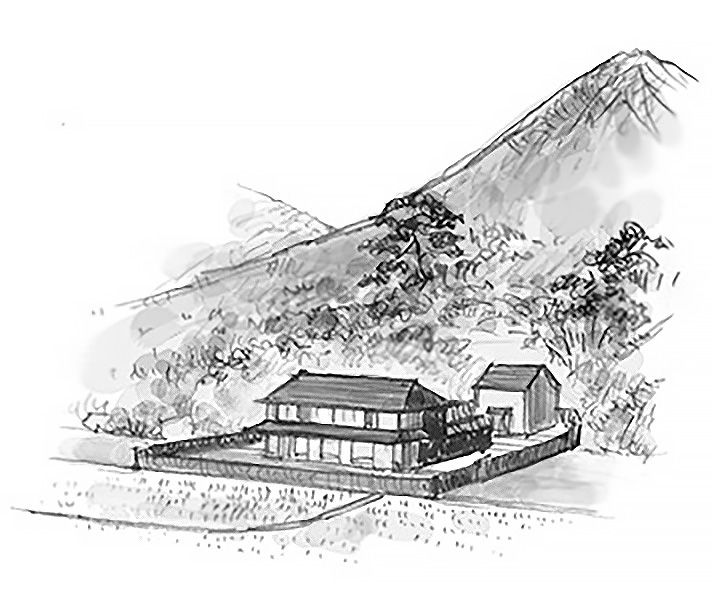
Siebold: A German Naturalist in Nineteenth-Century Nagasaki
History- English
- 日本語
- 简体字
- 繁體字
- Français
- Español
- العربية
- Русский
The Many Faces of the Doctor
Philipp Franz von Siebold (1796–1866) arrived in Japan in 1823, where he was assigned to work as a physician at the Dutch trading mission on the small island of Dejima in Nagasaki. Then just 27 years old, Siebold was to spend almost six years in Japan. During that time, he introduced the latest European medical discoveries to numerous Japanese students of rangaku (“Dutch” learning) at Narutaki-juku, the small school he established next to his surgery, and immersed himself in a study of Japanese botany. He also carried out market surveys with a view to boosting trade between Japan and the Netherlands, and had special instructions from the Dutch government to collect political and military intelligence on Japan. Beneath the public face of the doctor and natural scientist, there was much more to Siebold than most people realized.
Siebold was born into the German aristocracy, and chose to follow a medical career from an early age. He opened a medical practice after graduating from Würzburg University, but soon left the political and economic stagnation of his homeland behind in search of better opportunities elsewhere. At the time, the Dutch government was looking for a doctor to work in its trading enclave and was also eager to gather intelligence in Japan, where the Dutch were the only Europeans permitted to trade by the shōgun’s government. It wanted someone who could find out more about everything from plants to daily life, culture, the state of the nation and its borders, and military affairs. Siebold, from the Kingdom of Bavaria in the German Confederation, was the ideal candidate.
The Strange-Talking Hollander of the Mountains
As a Bavarian, Siebold had grown up speaking a variety of German quite different from the Low Germanic dialects spoken across northern Germany and the Netherlands, and it was some time before he felt comfortable speaking Dutch. When he arrived in Japan, the Japanese interpreter who interviewed him was suspicious of his impenetrable way of speaking and interrogated him closely on where he was from. Only Dutchmen were allowed to enter Japan at the time. It was left to the Dutch opperhoofd (chief factor) to save the day by explaining that the new arrival was “one of the mountain Hollanders (yama Orandajin), and speaks a strange dialect.” This inspired act of quick thinking was enough to get Siebold safely past the shōgun’s border guards.
In 1824, Siebold received permission from the shōgun’s representatives in Nagasaki and became the first foreigner to set up a small private teaching academy (juku) in Japan. It was located in a villa on land belonging to a Japanese interpreter in Narutaki on the outskirts of Nagasaki. The name of the new academy soon became well known among Japan’s scholars of Dutch learning. Doctors and others eager to find out about the latest developments in Western medicine flocked to Nagasaki to learn from Siebold. Narutaki-juku was a two-story wooden building with a garden planted with medicinal herbs and other plants gathered by Siebold and his students from all over Japan.
Siebold assigned each of his students to study a particular area in each field and had them submit reports to him in Dutch. Mima Junzō compiled a treatise on childbirth, based on the work of earlier Japanese writers. Totsuka Seikai and Ishii Sōken submitted a translation of a four-part Japanese treatise on the ancient East Asian use of moxibustion as a medical treatment. Many of the Japanese who studied at Siebold’s juku became pioneers of Western modern medicine and biology in Japan.
Gathering Intelligence
Siebold’s students came from all over Japan. Through his interactions with them, Siebold was able to gather a huge amount of information about the country. As well as being a base for his teaching, Naruyaki-juku was also the headquarters of Siebold’s efforts to collect as much intelligence as he could about Japan.
Siebold never accepted charges for his medical services. His patients often left artworks or handicrafts out of gratitude. The Dutch king had apparently promised Siebold an allowance of 12,000 guilders (around ¥250 million in today’s money) to build up a collection of Japanese artworks. Among his many other responsibilities, he was also an art collector who bought directly for the royal household.
Spying in Edo?
At regular intervals, the head of the Dutch trading mission in Nagasaki traveled to visit the shōgun at his castle in Edo (modern Tokyo). After traveling in procession from distant Nagasaki, the Dutch traders would pay obeisance to the shōgun, presenting gifts and swearing loyalty. This official procession to Edo presented Siebold with a rare opportunity to find out more about the shōgun’s capital, and one he was determined not to miss. At the time, foreigners were strictly forbidden from roaming about the country, and the Dutch were rarely allowed outside the confines of their small trading post. In 1826, Siebold took part in the procession led by Johan Willem de Sturler, the opperhoofd at the time. Along with a team of Japanese interpreters, Siebold took several of his juku students as his personal assistants. The artist Kawahara Keiga was also in the entourage, and was responsible for keeping a pictorial record of the scenery and customs they encountered on their long journey.
The Dutch mission always stayed at the Nagasakiya in Nihonbashi, a unique inn that catered specifically for envoys from the Dutch mission. Siebold met numerous people during his stay at the inn. Particularly significant was his meeting with the well-connected and well-informed Mogami Tokunai. Mogami was an explorer who had helped to map what is now Hokkaidō and some of the surrounding islands during the late eighteenth century. More recently, his protégé Mamiya Rinzō had undertaken major surveying expeditions in Sakhalin and the surrounding area. Siebold begged Mogami for his maps of Ezo (modern Hokkaidō) and Karafuto (Sakhalin). Like many people at the time, he wanted to know for sure whether Sakhalin was an island or was connected to the Asian landmass. Japanese law strictly forbade allowing maps of Japan to pass into foreign hands, so Mogami was careful to whisper his reply: “I can’t give you the maps. But I can lend them to you for a while. But you must promise not to tell anyone else . . .”
Many people visited the inn specifically to meet Siebold. One of them was Takahashi Kageyasu, the shōgun’s senior official in charge of documents, who visited Nagasakiya on numerous occasions. The maps of Japan drawn by Inō Tadataka and others still showed gaps along the northern coastlines that Takahashi wanted to check against Siebold’s copy of A Voyage Around the World by Krusenstern, who had led the first Russian circumnavigation of the world. Takahashi offered to give Siebold a copy of one of the latest maps of Japan in return for Krusenstern’s book. The map was a chart that showed the Japanese coastline all the way to Sakhalin and the Kuril Islands.
Besides his collecting and teaching activities, Siebold also found time to put down personal roots in Japan. He became intimate with a local courtesan Taki, known professionally as Sono Ōgi and the two had a daughter together called Ine. The girl grew up to become famous as the first female doctor to practice Western medicine in Japan.
The Siebold Incident and Deportation
In 1828, a major scandal broke out that led to Siebold’s being expelled from the country. A Dutch trading ship about to leave Nagasaki for the Dutch East Indies was swamped by storms and ran aground. During the attempt to rescue the foundering vessel, Japanese officials discovered many of Siebold’s most treasured secrets already stowed on board, including maps of Japan, plans of Edo Castle, and surveys of Sakhalin. Most of these items were things Siebold had collected by various means during his trip to Edo. Taking any of them out of the country was strictly forbidden. The detailed map of Sakhalin that he had received from Takahashi was a particular problem.
Official suspicion soon fell on Takahashi himself. Takahashi had known that the government would regard copying the map and giving it to Siebold as a serious crime, but he was convinced that his deal with Siebold was in the country’s best interests. For Takahashi, it was a crime of conviction. Takahashi was arrested and admitted that he had given the forbidden items to Siebold. Siebold himself insisted that he was interested in the maps only as part of his studies of Japan’s fauna and flora, and denied that he was a spy. Takahashi was reprimanded and Siebold’s collection confiscated. After interrogation, Siebold was banished from the country.
Perry and Siebold: Two Differing Approaches
Siebold returned to the Netherlands in 1830 and took up residence in Leiden. Drawing on the huge collection of materials he had brought back, he published the colossal study Nippon in 1832, in addition to a study of the flowers and of Japan. This second book, Flora Japonica, records that Siebold, who loved hydrangea, gave the scientific name H. otaksa to a species of the flower that bloomed near Narutaki-juku after his wife. A subsequent work on the fauna of Japan introduced people in Europe to the Japanese giant salamander.
 A sample of a hydrangea leaf that was displayed at the exhibition “Siebold: The Man Who Showed Japanese Nature to the World.” This variety of hydrangea bears the scientific name H. otaksa, after his Japanese “wife,” Taki. (Photo courtesy of The University Museum, University of Tokyo)
A sample of a hydrangea leaf that was displayed at the exhibition “Siebold: The Man Who Showed Japanese Nature to the World.” This variety of hydrangea bears the scientific name H. otaksa, after his Japanese “wife,” Taki. (Photo courtesy of The University Museum, University of Tokyo)
 Siebold obtained two specimens of the salamander in Japan and sent them alive to Holland. One of them survived the long journey and lived for more than 50 years in captivity. (Photo courtesy of National Museum of Nature and Science)
Siebold obtained two specimens of the salamander in Japan and sent them alive to Holland. One of them survived the long journey and lived for more than 50 years in captivity. (Photo courtesy of National Museum of Nature and Science)
Not long after Siebold’s hurried departure, Commodore Matthew Perry arrived in Uraga in 1853 bearing a letter from US President Millard Fillmore. Although Siebold’s intelligence on Japan was highly useful to Perry, the American was suspicious of the Dutch presence in Japan. He refused all offers of Dutch assistance and was adamant that the United States would open Japan to trade in its own way.
Kobayashi Jun’ichi, deputy head of the Edo-Tokyo Museum and one of the organizers of the exhibition Revisiting Siebold, says the two men had very different approaches to opening: “Perry knew Siebold, but he chose not to follow his approach and decided to open Japan to international trade as quickly as possible, backed by the threat of military force. As a result, the bakufu [shogunate] collapsed and Japan’s isolation policy came to an end. Although their ultimate aims may have been the same, Siebold wanted to open the country gradually through an increase in trade.”
 The exhibition Revisiting Siebold recreates the displays of Japanese artifacts shown by Siebold after his return to Europe in the nineteenth century.
The exhibition Revisiting Siebold recreates the displays of Japanese artifacts shown by Siebold after his return to Europe in the nineteenth century.
Although Siebold may have lost out to Perry in terms of opening Japan to international trade, in an academic sense his contribution to Japanese studies in the West had much greater significance. His writings and private collection were responsible for introducing many European people to Japan for the first time, including at the Paris Expo in 1900. For many years, his collection of Japanese objects and curiosities was open to the public from his house in Leiden, paving the way for the japonisme movement that swept through Europe in the late nineteenth and early twentieth centuries. One hundred and fifty years after his death, Siebold continues to be an important figure—particularly in Japan. His contributions to Japanese studies in Europe and Western learning in Japan deserve to be remembered and celebrated.
Revisiting Siebold and His Museum of Japan
Nagasaki Museum of History and Culture
Dates: Saturday, February 18 to Sunday, April 2, 2017
National Museum of Ethnology, Osaka
Thursday, August 10 to Tuesday, October 10, 2017
(Originally written in Japanese by Nagasawa Takaaki and published on November 30, 2016. Illustrations by Izuka Tsuyoshi.)
